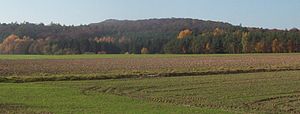Stiefenberg
| Stiefenberg | ||
|---|---|---|
|
Stiefenberg |
||
| height | 396 m above sea level NHN | |
| location | near Baunach-Godeldorf , Bamberg district , Bavaria | |
| Mountains | Mountains of hate | |
| Coordinates | 49 ° 59 '21 " N , 10 ° 48' 47" E | |
|
|
||
| rock | Keuper | |
| Age of the rock | about 200 million years | |
The Stiefenberg (also known as the step mountain ) is next to the Kraiberg, the second large local mountain of the city of Baunach . The two mountains are separated from each other by the valley of the Baunach river . It belongs to the Hassberge and thus to the Franconian Keuper-Lias-Land . The ruins of the former step castle are also located on it . The mountain, which consists mainly of Keuper , is 396 m high and, with the exception of the lower slopes used for agriculture , is forested. Common tree species are the spruce and the beech .
Mining on the Stiefenberg
Local tradition locates a former gold or silver mine on the Stiefenberg . The chronicler A. Schenk passed on the legend of two miller's boys who once saw a pile of gold pieces flashing between two flames on the Stiefenberg. Despite numerous spooky figures along the way, the two people from Baunach raised the treasure, which, however, brought them no luck.
In the State Archives Bamberg should (1974), a document from the 15th century are, where access is described to an ancient gold mine by Karl Crimea. Research was carried out on this under Prince-Bishop Adam Friedrich von Seinsheim (1755–1779). A man-deep shaft was dug in the Silbergrube forest department and a tunnel was driven forward. Until the onset of winter, however, no traces of precious metals were found . The work was stopped and not continued in the next year.
About 150 years later, in the first years of the Third Reich , an estate administrator came across the above-mentioned document in the archives of Untermerzbach Castle and again applied for permission to build a tunnel. The old excavation of the 18th century and allegedly even old tools were discovered quickly. However, gold and silver were again not discovered.
The three-humped Stiefenberg has not revealed its secret to this day. However, the traditions could well go back to a true core. However, the yield from a mine on the Waldberg should have been rather low.
tourism
Due to the numerous hiking trails, the entire mountain is very attractive for local tourism. Furthermore, numerous information boards for hikers not familiar with the area have been set up by the nature park administration.

